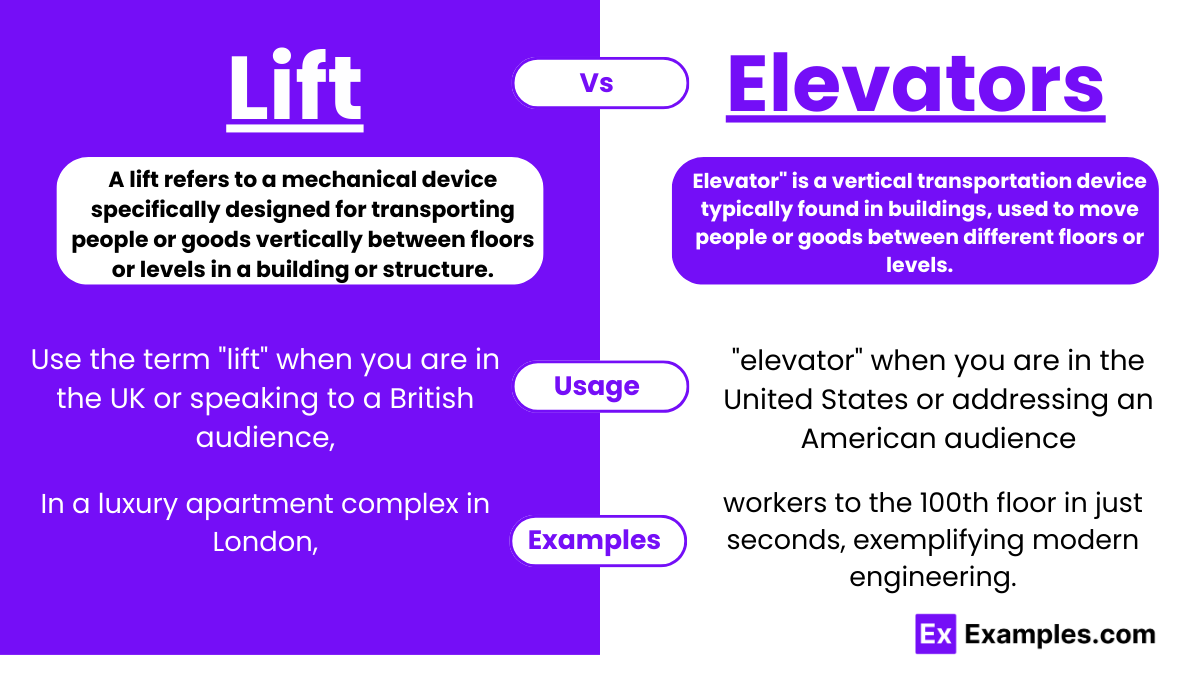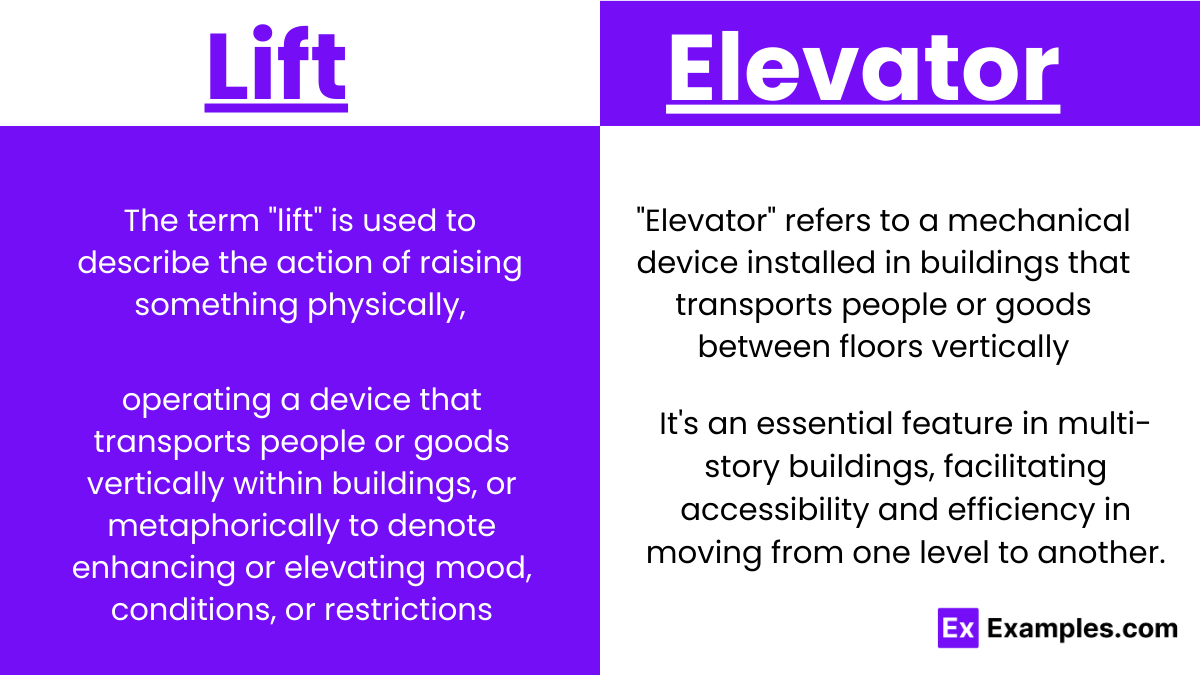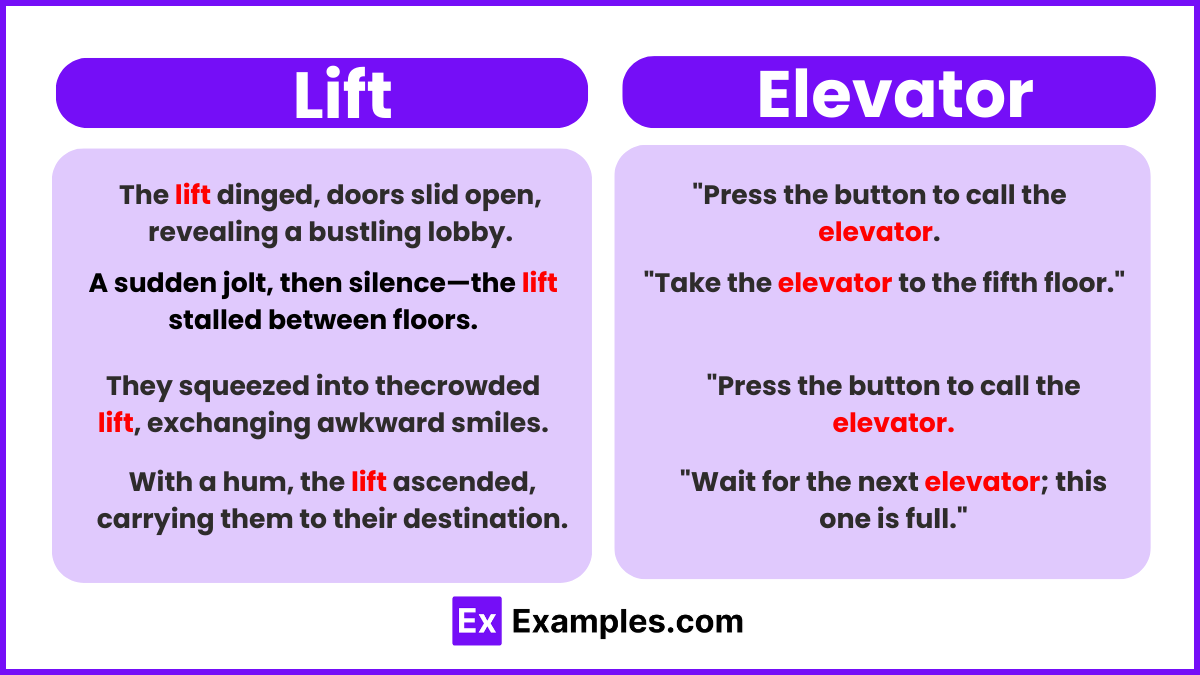Lift vs Elevator- Examples, Difference, Usages, How to use
In modern architecture and daily life, lifts and elevators play a pivotal role in providing vertical transportation solutions in buildings and structures across the globe. Although the terms are often used interchangeably, they originate from different regions and have slight variations in usage and connotation. This article delves into the subtle differences and uses of these two terms, providing insight into their functionality, design, and cultural significance.
Lift vs Elevator – Meaning
- A lift refers to a mechanical device specifically designed for transporting people or goods vertically between floors or levels in a building or structure. Predominantly used in British English, the term encapsulates a wide range of types including passenger lifts, service lifts, and goods lifts, each tailored to suit different needs and capacities. Lifts are integral to modern architecture, especially in high-rise buildings, where they facilitate easy and efficient access to various levels, significantly enhancing convenience and functionality.
- An elevator, on the other hand, is the term commonly used in American English to describe a transport system that moves people or freight vertically within a building or other structure. Like lifts, elevators come in various designs and capacities, including passenger, freight, and service elevators, to accommodate different vertical transportation needs. Elevators are critical in modern construction, enabling the design of taller, more accessible buildings and playing a key role in urban development and accessibility.
Summary
Although “lift” and “elevator” may seem different, they refer to essentially the same technology—a vertical transportation system used to move people or goods between different floors or levels within a structure. The primary difference lies in regional language preferences, with “lift” being favored in British English and “elevator” in American English. Regardless of the term used, these systems are fundamental to modern architecture, offering crucial benefits in terms of accessibility, convenience, and efficient use of space. Both lifts and elevators have evolved to meet various needs, including passenger, freight, and service requirements, thus becoming indispensable in the vertical layout of contemporary buildings and cities.
How to Pronounce “Lift” vs “Elevator”
Pronouncing the words “lift” and “elevator” correctly can enhance your clarity in communication, especially when discussing vertical transportation systems in different regions. Here’s a simple guide to mastering the pronunciation of these two terms.
Lift
- Phonetic Spelling: /lɪft/
- Pronunciation: The word “lift” starts with the “l” sound, where the tip of your tongue should lightly touch the back of your front teeth. The vowel sounds like the “i” in “sit” or “bit,” and the word ends with a “ft” sound, requiring you to briefly stop the airflow with your vocal cords before releasing it.
Elevator
- Phonetic Spelling: /ˈɛl.ɪ.veɪ.tər/ (British English), /ˈɛl.ə.veɪ.t̬ɚ/ (American English)
- Pronunciation:
- British English: Begins with the “el” as in “elbow,” followed by a short “i” sound like in “bit.” The third syllable sounds like “vay,” emphasizing a clear “ay” sound as in “day.” It ends with “tər,” where the “r” is softer and less pronounced.
- American English: Similar to British, but with a notable “ə” (schwa sound) in the second syllable, making it “el-uh-vay-ter.” The “t” in “vay-t̬ɚ” is a flapped “t,” sounding almost like a soft “d,” and the final “r” is pronounced more strongly.
Difference Between Lift and Elevator
Here’s a table summarizing the key differences between a lift and an elevator:
| Aspect | Lift | Elevator |
|---|---|---|
| Regional Usage | Predominantly used in British English. | Mainly used in American English. |
| Terminology | The term emphasizes the action of moving or raising to different levels within a structure. | Focuses on the capability to elevate or lift people or goods to different floors. |
| Varieties | Includes passenger lifts, service lifts, and goods lifts, each designed for specific purposes. | Features passenger elevators, freight elevators, and service elevators, catering to different vertical transportation needs. |
| Functionality | Designed to transport people or goods vertically between floors in a building. | Serves the same purpose of moving people or freight vertically within structures. |
| Cultural Significance | The term is ingrained in British culture and is commonly used across the UK and many other countries influenced by British English. | Embedded in American culture, with the term being widely recognized and used across the United States. |
When to Use Lift vs Elevator
Choosing between “lift” and “elevator” primarily depends on the regional language preference of your audience or the geographical location you are referring to. Here’s a straightforward guide on when to use each term:
Use “Lift” When:
- You’re in the UK or Commonwealth Countries: In British English and countries influenced by it, such as Australia, New Zealand, and South Africa, “lift” is the commonly used term.
- Communicating with a British Audience: If your readers or listeners primarily use British English, “lift” will be more familiar and understood.
- Referring to British English Contexts: In academic or professional settings where British English is the standard, such as certain international organizations or journals, “lift” is appropriate.
Use Elevator When:
- You’re in the USA or Canada: “Elevator” is the standard term in American English, which includes the United States and Canada.
- Communicating with an American Audience: If your audience is predominantly American or accustomed to American English, using “elevator” will resonate better.
- Referring to American English Contexts: In situations where American English is the norm, such as US-based companies or publications, “elevator” is the preferred choice.
Synonyms for Lift and Elevator
Here’s a table presenting synonyms for “lift” and “elevator,” providing alternative terms that can be used in various contexts.
| Lift (UK) | Elevator (US) |
|---|---|
| Hoist | Hoist |
| Conveyance | Conveyance |
| Elevator (in international contexts) | Lift (in British-influenced contexts) |
| Vertical Transport | Vertical Conveyor |
| Aerial Lift (for specific types) | Aerial Lift (for specific types) |
How to Use Lift vs Elevator
The choice between “lift” and “elevator” primarily hinges on the regional dialect of English you are using or the audience you are addressing. Here’s a simple guideline on how to use each term appropriately:
- In the UK and Commonwealth Countries: Use the term “lift” when you are in the UK or speaking to a British audience, as well as in countries that follow British English conventions, like Australia, New Zealand, India, and South Africa. The term is ingrained in these cultures and widely understood.
- In the USA and Canada: Opt for “elevator” when you are in the United States or addressing an American audience. The same goes for Canada, where American English influences are strong. The term “elevator” is part of everyday language in these regions.
- For International Audiences: If your audience is international or you’re unsure about their regional English preferences, you can choose either term based on the context or clarity you wish to provide. In technical or industry-specific documents, “elevator” is often used globally due to its prevalence in American English.
- In Writing and Formal Speeches: Be consistent with your choice of term throughout a document or speech to avoid confusion. If you start with “lift,” stick with it, and the same goes for “elevator.”
- When Quoting or Citing Sources: Use the term that is used in the original source to maintain accuracy and authenticity in your references
Examples of Lifts Elevators
- Residential Lifts: In a luxury apartment complex in London, a state-of-the-art residential lift provides smooth access to all floors, ensuring comfort and convenience for all residents.
- Hospital Lifts: A major hospital in Birmingham has several hospital lifts designed to accommodate stretchers and large medical equipment, facilitating quick and safe patient transport.
- Freight Lifts: In Manchester, a large warehouse utilizes heavy-duty freight lifts to efficiently move bulky goods between its storage floors, enhancing operational efficiency.
- Service Lifts: A high-end restaurant in Edinburgh uses a service lift to transport food and supplies between the kitchen on the ground floor and the dining area on the upper floor, ensuring seamless service.
- Platform Lifts: In a public library in Bristol, a wheelchair-accessible platform lift allows individuals with mobility challenges to access all areas of the library independently.
Examples of Elevators
- Skyscraper Elevators: In New York City, the latest skyscraper boasts high-speed elevators that transport office workers to the 100th floor in just seconds, exemplifying modern engineering.
- Home Elevators: In a suburban neighborhood in California, a newly constructed home features a sleek home elevator, adding luxury and increasing the home’s value.
- Glass Elevators: The central atrium of a shopping mall in Toronto features a stunning glass elevator, giving shoppers a panoramic view as they ascend to different levels.
- Observation Elevators: At the Chicago Observation Tower, visitors use an observation elevator to reach the observation deck, enjoying breathtaking views of the city as they ascend.
- Dumbwaiter Elevators: In a historic hotel in Boston, a dumbwaiter elevator is used to discreetly transport laundry and supplies between floors, preserving the aesthetic and historical integrity of the hotel
Synonyms for Lift and Elevator
Here’s a table presenting synonyms for “lift” and “elevator,” providing alternative terms that can be used in various contexts.
| Lift (UK) | Elevator (US) |
|---|---|
| Hoist | Hoist |
| Conveyance | Conveyance |
| Elevator (in international contexts) | Lift (in British-influenced contexts) |
| Vertical Transport | Vertical Conveyor |
| Aerial Lift (for specific types) | Aerial Lift (for specific types) |
Exercise
Fill in the Blanks Questions on Lift and Elevator
- The _________ in our building goes directly to the 10th floor without stopping.
- For moving heavy goods to higher floors, the service _________ is more suitable than the passenger one.
- Due to maintenance, the _________ will be out of service until further notice.
- In many modern homes, a small _________ is installed to assist those with mobility challenges.
- The _________ in the shopping mall offers panoramic views of the entire shopping area.
- Safety inspections for the _________ are conducted regularly to ensure all mechanisms are functioning properly.
- The _________ doors failed to open because of a power outage earlier today.
- To access the rooftop garden, visitors can take the _________ to the last floor.
- The historical building was retrofitted with a _________ to make it accessible for everyone.
- During the fire drill, we were reminded never to use the _________ and to take the stairs instead.
Answer Key:
- Elevator/Lift
- Elevator/Lift
- Elevator/Lift
- Elevator/Lift
- Elevator/Lift
- Elevator/Lift
- Elevator/Lift
- Elevator/Lift
- Elevator/Lift
- Elevator/Lift
FAQs
Why Do British People Say Lift Instead of Elevator?
British people say “lift” due to historical and linguistic preferences in the UK, where “lift” originated as a term for mechanical devices that raise or lower goods or people, predating the American term “elevator.”
Do Americans Say Lift or Elevator?
Americans predominantly use the term “elevator.” “Lift” is understood but rarely used, reflecting the American English preference for different terms in various aspects of language.
Do Australians Call Elevators Lifts?
Yes, Australians commonly call elevators “lifts,” reflecting British English’s influence on Australian English. This terminology is consistent across many British Commonwealth countries.
Is Lift British or American?
“Lift” is primarily a British term. It is used in the UK and other countries influenced by British English to refer to what is known as an “elevator” in American English.
What Countries Call an Elevator a Lift?
Countries that call an elevator a “lift” typically include those with strong British influence, such as the UK, Australia, New Zealand, Ireland, and South Africa, among others in the Commonwealth.
In What Country Do They Call an Elevator a Lift?
In the UK, the term “lift” is used to refer to what Americans call an “elevator.” This usage reflects the linguistic preferences and traditions of British English




